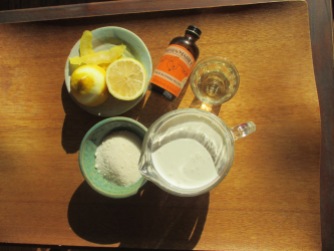The day after Christmas I opened my laptop and started transcribing a page of Constance Hall’s recipe book, Folger Shakespeare Library MS V.a.20. I did this every day for twelve days as part of an Early Modern Recipes Online (EMROC) holiday Transcribathon. I transcribed sitting next to my sister-in-law, in the early morning hours before a pre-semester faculty meeting, after yoga, and at the end of a long day of preparation for the Modern Language Association conference. It was nice to pause amidst the festivity, work, and routine to transcribe a few pages of Constance Hall’s book. It’s not that I never complete transcriptions anymore – I transcribe lots of recipes for this site and other related projects – it’s just that I usually skim physical or digital recipe books looking for recipes I’m excited to cook, rather than transcribing everything on a page, fussing over abbreviations, musing about alternate spellings, and puzzling through tricky lines. Transcribing daily reconnected me to my research for this project in a new way, honed my skills, and, of course, added many recipes to my long “to cook” list.

The EMROC blog has a wonderful post with background information about Constance Hall and her manuscript.
Hall’s lovely, calligraphic title page is dated 1672. I decided to try this recipe for “selebub,” or syllabub first because syllabubs were all the rage in the last decades of the seventeenth century when Hall compiled her manuscript. Alyssa’s “Solid Sillibib” post offers an excellent account of this syllabub craze and she includes many transcribed recipes from other manuscripts as examples of the trend. I’m also tipping my hat to Gina Patnaik and Lili Loofbourow whose epic quest to make a birch whisk to stir their syllabub over at The Awl still leaves me in awe.
The Recipe
To make selebubbe
Take 2 quarts of cream and sweet[en]
it and put it in to a bason and squise
in to lemons in to it and on of the p[eel]
put in a quarter of a pint of sack and
put in one drop of oring flower water
take out the lemon whip it with a cl[ean]
whiske and put it in your glasses halfe
this will fill seauen
Our Recipe
Since the recipe notes that it will fill seven syllabub glasses half full (serving seven), I quartered the recipe. These proportions produced a quart of syllabub. I also guessed on the sugar and used sherry for the sack.
2 c cream (1 pint)
1/3 c sugar
half a lemon: peel cut into long strips, then juiced
2 T sherry (for the sack)
1/4 t orange blossom water
Optional: extra grated zest (orange and/or lemon) to serve
Stir together the cream, sugar, lemon juice, sherry, and orange blossom water. Add the lemon peel. Let sit for 1 hour.
Remove the lemon peel. Whisk until a stiff foam forms using a standing mixer, a handheld mixer, or a whisk. Serve in small glasses or bowls.
The Results
The most decadent whipped cream I’ve ever tasted: This is my best effort at describing the syllabub. It’s sweet, but not too sweet. It’s slightly boozy, but grounded by the acidity of the lemon and the unavoidable creaminess of the, well, cream.
I want to spoon it over chocolate ice cream. I want to spread it on dense, rich cake. I want to serve it with poached or roasted fruit. Basically, I want to eat it in the least seventeenth-century way possible. I’m not especially interested in sipping or spooning it from a glass. I’m curious to see what happens with the rest of the batch over the weekend.








“Basically, I want to eat it in the least seventeenth-century way possible.” Ha! This made me laugh. A decadent whipped cream sounds delicious.
I’m curious about your reasoning that this “will fill seven syllabub glasses half full”. The syllabub glasses that I’m familiar with (here’s a typical example http://tinyurl.com/j6de56o) seem to have a volume of about one cup. Seven of these would be much less than two quarts of cream before whipping, let alone after it was inflated. Was there some syllabub serving bowl in those days, analogous to a modern trifle bowl, that the author could have been referring to?
That’s what the recipe says! (See transcription above.) The glasses might refer to a larger bowl.
I have no inventory of antique syllabub glasses, but I believe they came in more than one size. Colonial Williamsburg sells a 4 ounce and 8 ounce I believe. One of the neatest tricks I found in making syllabub was one receipt that directed that you scrape the lemon on your loaf of sugar, thus rasping the lemon rind and flavoring the sugar, which you then added to the syllabub. This technique also preserves the wonderful lemon oil essence.
Mercy, that’s a fantastic trick! The lemon oil is key and that method harnesses it wonderfully.
We have a medieval syllabub recipe that we make when we do re-enactment at Raglan Castle every August. It requires four things (other than containers): white wine, sugar, cream….and a wall.
Mix the wine and sugar in a large bowl, and put the cream in a pitcher. Grab another pitcher of water and climb the wall with both; stand on top of the wall and have someone place an empty bowl under where the water falls when you pour it, so you don’t end up pouring cream onto the ground. Once you’ve got everything set up, pour the cream into the wine. The cream froths on the way down and whips as it hits the wine, and turns everything into a glorious boozy medieval milkshake. It is truly one of the highlights of our summer.
What a wonderful recipe! Thank you so much for sharing, Sara.
Pingback: To Make Appel Flitters | Cooking in the Archives